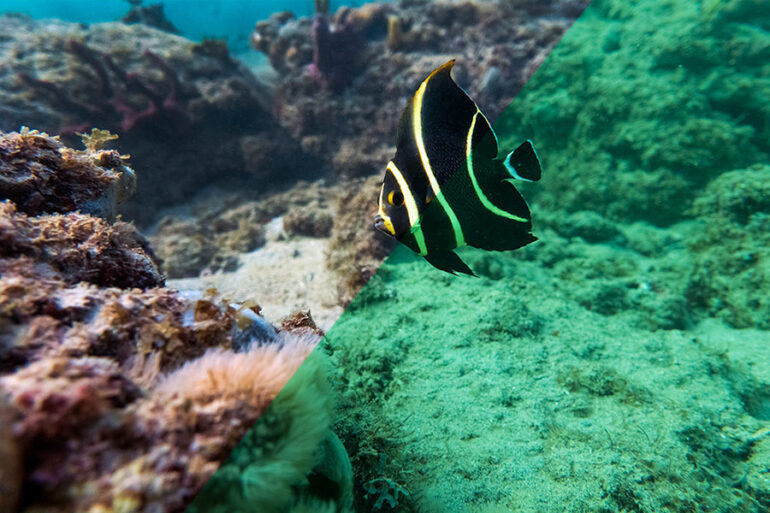We may earn a commission when you purchase through affiliate links. Learn more.
The underwater world can be a very colorful place, but many photographers aren’t sure how to reveal these colors, and lots of underwater photos end up looking very flat, with little contrast and have a very green color cast or tint. Colorful fish? Green. Vibrant coral? Green.
The reason why everything tends to look blue and green underwater is because sunlight carries a full spectrum of colors, but the red and orange wavelengths of light are absorbed by the water much more quickly. Consequently, most of the red colors underwater have already been absorbed at just a few meters in depth and by ten meters, nearly all of the red colors have been absorbed. Because shorter wavelengths of light like the colors blue and green can penetrate the water to deeper levels, the farther below the surface you go, the more everything begins to take on a bluish-green tint — you’ll find that even when you’re trying to take pictures in a pool, the closer to the bottom you are, the less colorful things look.
Take a look at the shot above and hover your mouse over it or if you’re on a mobile device, just tap it to reveal the true colors of this underwater scene. In the original, taken with a Sony RX100 III in an underwater housing at about 15 feet below the surface, everything looks green. Green rocks, green coral, green sea fans….green shark. The underwater world is a vibrant, colorful place, but without a little bit of know-how it’s tough to actually capture the true colors beneath the surface without the entire picture looking like pea soup.
You’ve got a few options for restoring the true colors in your underwater photos taken with smaller cameras:
1. Use artificial lights. Smaller cameras without a built in flash like the GoPro Hero 5 Black can benefit from a continuous light like the 600 lumens Light & Motion Sidekick Duo, which can help to illuminate nearby subjects in lower light underwater, especially for close-up shots and when capturing video.
Compact cameras that have a built in flash like the Sony RX100 IV and Canon PowerShot G7 X Mark II can be used with compatible underwater housings and can trigger an underwater slave flash like the Intova PX21 or Sea&Sea YS-01 which are able to fire when your camera flash fires. Much like flash units designed for use on land, underwater strobes come in a wide variety of power-outputs, with some providing more light to a scene than others.
2. Make use of a red filter. Because so much red light is absorbed underwater in even relatively shallow water, using a red filter like the Fantasea RedEye Filter M67 (for housings with 67mm filter threads) can help to correct for the greenish tint in underwater photos. The effectiveness of a red filter will depend upon the particular color of the water – in very green water, you may find that a magenta filter offers better results. While a filter can help improve the appearance of your photo, it won’t add more light into your scene — you’ll need to use a video light or strobe to actually boost the lighting underwater.
3. Use a Custom White Balance. Many cameras allow you to set a custom white balance, basically telling the camera which part of your scene is white, so that it can adjust the white balance accordingly.
4. Shoot RAW. If your camera gives you the option to shoot in RAW, you’ll find that you have a lot of latitude to color correct your image back on land. Different photos will require different post-processing approaches, but if the lighting remains similar and you remain at a similar depth during the entire dive, you’ll usually find a recipe that works quite well for most of your shots.
5. Take pictures in bright sunlight. Bright sunny days mean more sunlight, and the brighter the sunlight, the more red and orange light will be passing through the water. In deeper water where very little red light ever reaches, a sunny day won’t make much of a difference, but in shallower water a sunny day means that you’ll have more vibrant colors than in overcast weather.
Want to learn how to take better underwater photos? Start with our guide on How to Take Pictures Underwater! You’ll also find plenty of great information in any of these ten books listed in our underwater photography book buying guide, and if you’re searching for an underwater camera to begin shooting with, check out our buying guide to waterproof compact cameras.

